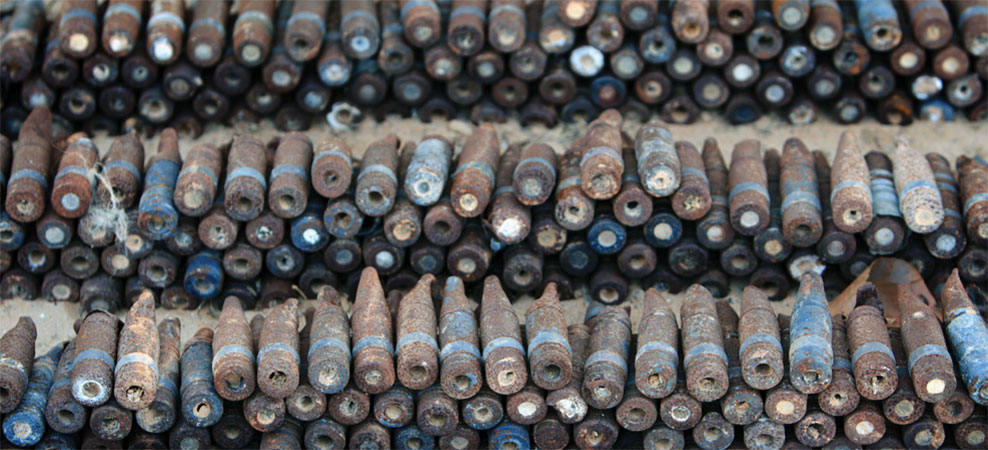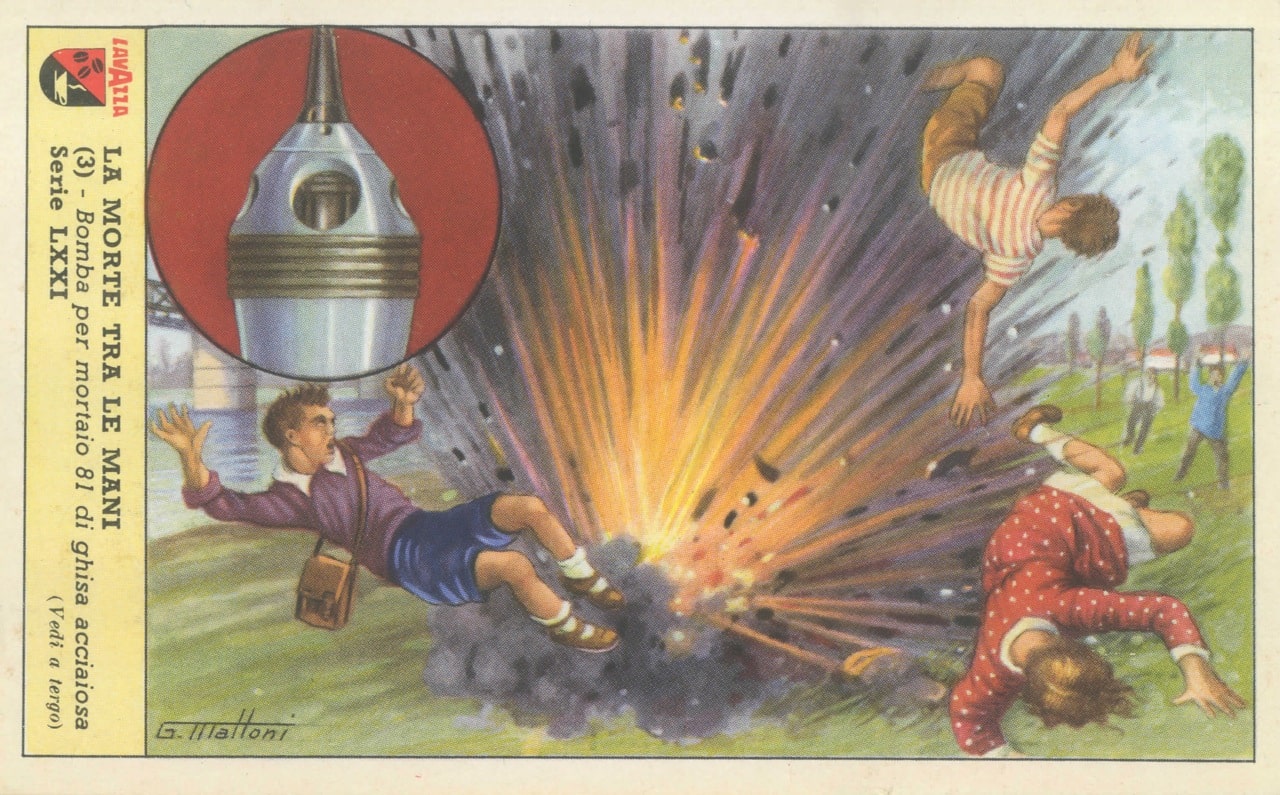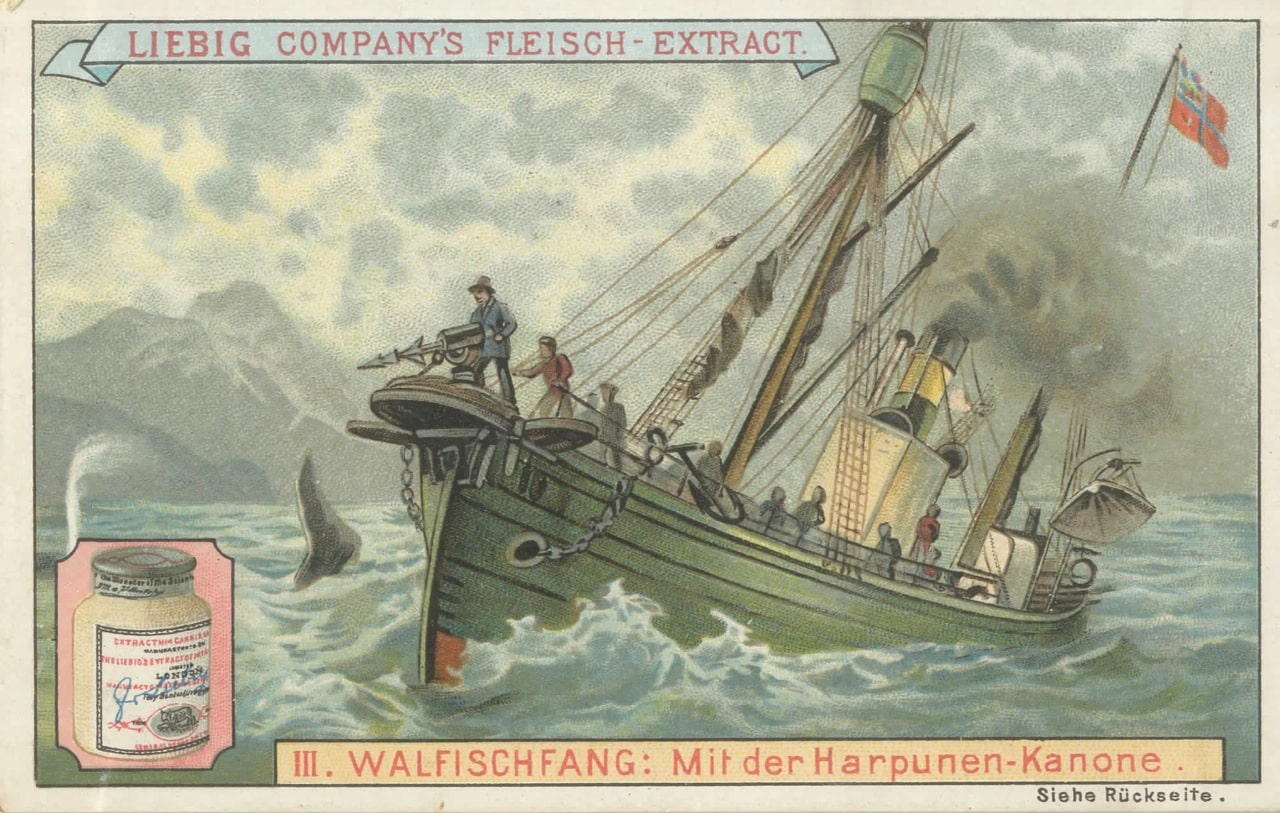
Mine explosives © UNMAS/Giovanni Diffidenti
Explosives: Prime Movers of the Anthropocene
Combustion engines, dynamite fishing, and the violent reshaping of terrestrial and marine landscapes: philosopher and chemist Jens Soentgen considers explosions as a key principle of modernity and the creation of modern explosives as a turning point not only for human history but also for the history of ecological disruption.
In a recent book, environmental scientist and historian Vaclav Smil named the diesel engine and the gas turbine as two prime movers of our time.Vaclav Smil, Prime Movers of Globalization: The History and Impact of Diesel Engines and Gas Turbines (Cambridge, MA: MIT Press, 2013). This is an important and understandable designation; but it should be amplified that even behind the diesel motor, even behind the gas turbine, resides a key principle—namely that of explosion. This principle is a fundamental signature of modernity, characteristic of the technosphere at large. It shapes modern society as well as our relations to nature.
There used to be more awareness of this fact. In Germany, gasoline motors and diesel motors were initially called “explosion motors.” Today they are named internal combustion engines. However, the initial denomination is more convincing, as they are based on a sudden unleashing of energy. Here as everywhere, explosions facilitate the instantaneous, radical expansion of power, which prevails against all obstacles.
In addition to the controlled explosions in the diesel engine, however, there are also explosives created to destroy structures. These can also be seen as prime movers of our time, because they produce the tabula rasa that is the sign of human deployment of power in the Anthropocene. Modern explosives are indispensable in mining, in tunnel and canal building, and in modern firearms. They are ecologically and politically of upmost importance. For this reason, it is unfortunate that to this day we still have no history of explosives oriented toward ecology and politics; even technological and chemical histories of these substances are only rudimentary.
Only by thinking ecology, politics, and chemistry together through the example of explosives can we gain a new understanding of decisive turning points, especially those in the late nineteenth century, when the state of organic chemistry allowed for a shift from alloy to molecule with explosives; that is, for not only bringing the elements involved in the reaction into contact externally, but merging them in a labile connection. This provided enormous gains in efficiency and explosiveness, which made possible much later innovations, from machine guns to modern artillery.
A Violent, Incomparable Invention
The modern word “explosion” derives from the Latin explosio, which means “hissing, laughing at, and booing,” especially of bad actors, a drastic show of disregard in the theater, the opposite of applause. An explosio was an aggressive noise used for rejecting and demolishing. The modern usage has departed significantly from this origin, but not so far that we cannot link the modern word back.
Today we usually use “explosion” to mean an abrupt, expansive chemical reaction, during which there is a sudden unleashing of power. With this sudden emergence of great pressure, the temperature rises abruptly, and there is a loud bang to hear and a flash to see. The explosion can be viewed as one of the principles of modernity, as it stands at the root of many of the destructive transformations of nature that began in the modern era. European expansionism since the early modern period is also hard to imagine without the mastery of the compressed and intensified fire of explosions. This is not a particularly new insight, at most somewhat novel in its formulation. For centuries, gunpowder was seen as one of the most important human inventions, even if it is unclear if its origins were not perhaps evil indeed.

large
align-left
align-right
delete
The praise of the metallurgist Vannocio Biringuccio from Siena, sounds particularly euphoric, but at the same time ambivalent, declaring gunpowder to be a “violent, incomparable invention, whether it was invented through demonic influence or by chance.” The idea that a benevolent God could have given humans gunpowder is not entertained by Biringuccio. When using this nondescript powder, he continues, there are “such horrendous and dreadful appearances, as if violent flashes or horrendous earthquakes were inserted into it.” One could “knock down” giant buildings “with little effort.” Whole mountains could be opened up “to rummage about in their innards.”Vannoccio Biringuccio, Pirotechnia (Venice: Gironimo Gilio, 1559), 314–15. There was nothing, concludes the Italian scholar, that could not be eliminated or at least heavily damaged by the power of gunpowder.
Gunpowder, the raw materials of which—coal, sulfur, and saltpeter—are all natural materials, more or less extracted as they are from nature, was the only known explosive material in Europe for more than seven hundred years. But by the nineteenth century its days were numbered. New powders needed to be invented. The idea was in the air at the time. Gun cotton, a saltpeter acid ester suited for explosion, was already discovered in 1846. Nitroglycerin was discovered in 1847 by Ascanio Sobrero, a doctor from Turin. Sobrero immediately had the idea to use the substance as an explosive, but an accidental explosion disfigured his face and he refrained from doing any other experiments on the sensitive material. The taming of nitroglycerin was achieved in the 1860s by the Swedish chemist Alfred Nobel. Nobel initially mixed it with gunpowder, but soon after used diatomite. He also developed other completely synthetic explosive materials for technological use through his invention of booster detonation, during which the main explosion is triggered by an earlier small explosion in the material itself. This principle invented by Nobel in the 1860s is essential for modern weapons technology as well as for civilian usages of modern, highly efficient explosives.Richard Escales and Alfred Stettbacher, Initialexplosivstoffe [Initial Explosives] (Leipzig: Verlag von Veit and Companie, 1917) (= 7th issue of Richard Escales: Die Explosivstoffe [The Explosives]), 26–39.
The idea of developing a new, more powerful powder relied not on simply mixing the materials that together cause the explosion, but on combining them in a way so that the atoms that react with one another lay side by side as a labile combination that only needs to come undone. At the appropriate occasion the molecules would react, and transform into hot gasses. Many combinations of nitrated carbons can become effective explosive agents. Guncotton, nitroglycerin, and TNT, but also nitroxanthic acid, are of this type. They were used in the 1870s to produce so-called smokeless powder, which had a much larger explosive force than ordinary gunpowder.
The nineteenth-century German chemist Bernhard Lepsius provides a good description of where the difference between gunpowder and the new, fully synthetic explosive materials lies:
In gunpowder we have a mixture of combustible materials, sulfur and coal, with the burning substance, saltpeter, with its high oxygen content. No matter how finely we pulverize them and how evenly we mix them, it always remains a mechanical mixture. Viewed under a microscope the elements lie separately next to one another. With the volatile explosive agents it is a different story. Here all the material necessary for incineration is already united in the molecule. All the oxygen that is necessary to burn the carbon and the hydrogen is already within the molecule, available at any moment. All that is needed is a trigger, a disturbance of the existing balance, to produce a new order of the atoms within each of the molecules. With one stroke each complex element of the trinitocellulose falls apart into numerous new, simpler, gas-like molecules.Bernhard Lepsius, Das alte und das neue Pulver [Old and New Powder] (Leipzig: Verlag von F.C. W. Vogel, 1891), 21. Lecture given at the 1st General Meeting of the 64th Congress of the Gesellschaft Deutscher Naturforscher und Aerzte in Halle a/S, Germany.
This also means that no undesirable byproducts arise in the explosion of this powder, such as smoke in the case of gunpowder. Forty-three percent of the energetic mass of gunpowder is transformed into useless smoke, but it is different with fully synthetic explosive materials. They release much more energy, because they completely turn into gas without any hard byproducts.Manfred R. Rosenberger and Katrin Hanné, Vom Pulverhorn zum Raketengeschoß. Die Geschichte der Handfeuerwaffen-Munition [From Flask to Missile. History of Handgun Munition] (Stuttgart: Motorbuch-Verlag, 1993), 28f.
Paul Vieille, a student of Marcellin Berthelot (that is, the chemist who coined the term “chemical synthesis”), found that the speed of incineration under high pressure is quite different than that in the open air.Louis Médard, “L’oeuvre scientifique de Pul Vielle (1854–1934),” [The Scientific Œuvre of Pul Vielle] Revue d’histoire des sciences 47, nos. 3–4 (1994): 381–404. But for propellants the highest possible speed of incineration is preferable. This can be achieved by giving the powders a form with the largest possible surface area, such as threads or laminae. Gunpowder, which at best can be granulated, is certainly completely inappropriate for this. With the newer substances, however, which can easily be gelatinized and then pressed into any form, this is all possible. Vieille in fact invented a functional fully synthetic gunpowder that was introduced in the French army in 1886 as Poudre B. Other armies later employed similar powders.Wilhelm Will, “Der Fortschritt der Sprengtechnik seit der Entwicklung der organischen Chemie,” [Progress in Blasting Techniques since the Development of Organic Chemistry]in Zeitschrift für Elektrochemie und angewandte physikalische Chemie, no. 10 (1904): 10. Nobel had also already developed a smokeless powder, ballistite, in 1884.Kenne Fant, Alfred Nobel. Idealist zwischen Wissenschaft und Wirtschaft [Alfred Nobel. Idealist between Science and Economy] (Basel: Birkhäuser Verlag, 1995), 308–10. After protracted negotiations with the French state, he sold it exclusively to the Italian army.
The improvement of gunpowder through organic chemistry is similar to the move from willow bark to aspirin, which also took place in the (late) nineteenth century. Instead of a mixture of natural products, a molecule was designed. Technology reached the level of atoms and began designing much more efficient substances, be it in the area of pharmacy or of high-energy materials.
Thanato-technologies
On various occasions it has been pointed out that the mines created by humans—our pits, tunnels, and caves—are among humanity’s most longstanding works, for they will still be visible in many thousands of years.Jan Zalasiewicz, Colin N. Waters, and Mark Williams, “Human Bioturbation, and the Subterranean Landscape of the Anthropocene,” Anthropocene, no. 6 (2014): 3–9. But not only mountaintop removal mining and other forms of surface or underground mining depend on explosives. The secure extraction of petroleum also depends on explosives, as they are the only means to stop oil well fires. The intensified fire and destructive energy of explosives is used here to control the fuel of our modern society. Explosives are also indispensable for the creation of traffic infrastructure and hydraulic engineering.
The great significance of explosives is not just political or geological but also ecological. Indeed, even wild animal populations are directly or indirectly reduced through the use of explosives.
In the context of colonialism, efficient European firearms, nets, and traps were exported to every continent, penetrating every part of the world. They introduced a new epoch in the history of extermination. In many cases, military innovations were quickly transferred into the realm of hunting. In 1864, the Norwegian shipping tycoon Svend Foyn mounted the cannon harpoons that he had developed onto a boat and went whale fishing. This harpoon made use of an explosive substance: it had barbed hooks that simultaneously discharged concentrated sulfuric acid and was fired at the animal with a cannon. For the first time in the war against the animal world, not only were poison, poisonous gases, spears and axes, traps and guns used, but also artillery. And so it became possible for the first time to successfully hunt the largest animal that has ever existed on Earth, the blue whale. These, like the other rorqual whales, could not be effectively hunted before because they were, firstly, too fast, and, if somehow successfully slain, they then sank too quickly. With the cannon harpoon, however, which exploded in the body of the whale, a new, efficient killing instrument had been devised that heralded the beginning of the modern whaling age. Further technological improvements on ships and the development of technology to inflate slain whales with compressed air to prevent them from sinking soon unleashed an unparalleled orgy of decimation. By the middle of the last century, the blue whale, as well as many other whale species, were nearly extinct.

large
align-left
align-right
delete
Nitroglycerin—that completely synthetic explosive in which the reactive components are not mechanically adjoined in a mixture but chemically bound in a molecule—was and is deployed in many places to hunt sea creatures. This kind of fishing seems to have been invented during the First World War and quickly spread over the entire planet. In the Mediterranean, illegal dynamite fishing, which was practiced there mainly in the middle of the twentieth century, has resulted in serious damage to the marine fauna. Today, this technique has spread extensively across Southeast Asia and Africa, because it is cheap, impressive, and, at first, efficient. It is also certainly devastating, since many more fish are harmed or killed than can later be consumed. This leads to the destruction of habitats, which come to resemble a submarine desert of wreckage. “We’re exterminating. After us the void,” writes Werner Helwig in his fictional, but apposite, “credo” of the dynamite fishermen.Werner Helwig, Raubfischer in Hellas [Predatory Fishermen in Hellas] (Frankfurt am Main: Büchergilde Gutenberg, 1952), 6. Author’s translation.
With firearms, explosives, and other thanato-technologies, animals were and are being hunted practically everywhere in the world. War is being waged on them, whether they fly, swim, crawl, or jump.
In short, while the politico-historical or military strategic consequences of explosives innovation have been well researched, their effects on ecology and culture have been less studied. Under the sign of the Anthropocene, however, a history of the principle of explosion and a history of explosives is an important goal. It shows that when it comes to energy—the theme so central to Vaclav Smil’s broad analysis of the modern world—what matters is not just quantitative sums, but also quality.